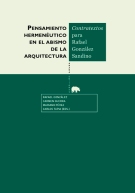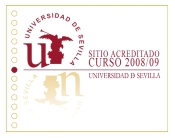
Defensa de tesis doctoral «SPATIUM NEGATIO. Transitions in urban space representation through the perspective of negativity», de la investigadora de outarquias Marta López-Marcos.
15 de junio de 2018, 11:30h
Sala Félix Pozo, ETS Arquitectura de Sevilla.
Dirigida por Carlos Tapia Martín (U. Sevilla), Grahame Shane (Columbia University, GSAPP), y Víctor Pérez Escolano (U. Sevilla)
El jurado está compuesto por:
Josep María Montaner. UP Barcelona. ETSAB
Carlos García Vázquez. U Sevilla. ETSAS
Carla Carmona Escalera. U. Sevilla Philosophy.
Polyxeni Mantzou. Democritus University of Thrace, Greece. Architecture
Daniel Jiménez Ferrera. U. Évora, Portugal.
Abstract
Modernity could be explained through the process of subordination of space to time. The Cartesian division between res extensa and res cogitans already established the differentiation of two independent realms: the fìrst, abstract, exterior and exceeding the realm of reason; the second, subjective and belonging to the inner dimension of mind, through which knowledge and thought are possible. Western thought progressively associated these dimensions to space and time respectively, the latter becoming the privileged realm of subjective interior, idemified with human spirit and the thinking subject. However, this historical negation of space was put into question after the so-called «spatial turn,» in which social sciences recovered space as a central category during decades of social, political and economic transformations in a global scale.
The understanding of space as a social product traversing multiple fìelds of knowledge led to a certain displacement of architecture, which until then had been considered to be the practically exclusive discipline of space. After decades of engagement with the progressive socio-political project of Western modernity and its subsequent crisis during the last decades of the twentieth century, architecture retreated imo questions of form and its autonomy as a discipline; a debate that persists today in cercain academic and professional circles.
Under this scenario, now amplifìed with the global hegemony of (Western) capitalism, a revision of the category of space seems pertinent in order to determine its contemporary relation to the formal and socio-political dimensions of architecture. Although now deprived from the strength of dialectical approaches -harshly criticized by the major currents of contemporary philosophy-, the perspective of negativity and its multiple connotations may offer a renewed theoretical framework from which to understand if space is still a relevant element for a contemporary architecture in crisis. In this regard, the field of urban public space, as an ideological construction that materializes in the city, appears as a fruitful fìeld of study in which to trace transitions between dominant conceptions of space during the last centuries through negations (understood as the overcomings of space from different areas: temporal, productive, visual…); reverses (understood as counterspaces, the term coined by Henri Lefebvre to designate alternatives to abstract, capitalist space), and the multiple spatial practices that configure and take place in this type of space, extending the purely architectural and urban action.
The project is structured around the relations between dominant conceptions of space and the forms of exteriority, the main membranes through which Being spills out facing otherness beyond its subjective limits. Therefore, the articulation of the work responds to a series of back and forth drives: five movements and counter-movements towards the realms of the physical city, the body in space and the actual-virtual relations between human and non-human agents, interrupted by three seductiones from non-Western contexts (Beijing, Warsaw and Istanbul) to alter the prescribed path and put into question the pervasive character of the notion of public space.
Table of contents :
(DE)CENTERING. 6
Diomede Islands. 10
Moonwatchers. 16
The Path of the Sun. 18
Decentering Europe (I). 29
Objectives of the project. 45
—
Challenging totalizing conceptions of space. 47
Counterspace and (ir)rationality as motor. 50
Socio-spatial processes in cities. 56
Architecture as a discipline. 57
Methodological approach. 60
Critical interpretive research. 66
Counterpublics and counternarratives. 70 (Extended) relational aesthetics. 72
Seductions and (counter)movements. 76
Spatium negatio. 89
Recovering negativity. 89
Space (as exteriority) and negativity. 106
Negative avant-gardes. Interactions in space, negativity and politics. 116
Counterspaces in the city. 134
On (the Politics of ) Space. 153
Space as a social product. 153
Architecture after the spatial turn. 165
Politics of the (global) city. 177
Public space? 192
(RE)PLACING (or how the Western notion of space is challenged through social practice in urban places) 217
Space and anti-space. 219
Leftover spaces. 232
The square as a socio-spatial product. 241
SE-DUCTIO I: BEIJING. 267
New regime, new spaces. 270
Tiananmen square. 275
From China to the West and back. 285
(EM)BODYING (or how the corporeal emerges as a particular membrane between the interior/exterior spatial gap) 302
Against architecture. 307
(Counter)revolution and autonomy. 317
New publics and bodies in motion. From panoptic to panchoreographic. 331
SE-DUCTIO II: WARSAW. 357
Spaces-in-between. Oskar Hansen and the Open Form. 367
Anti-city, anti-monument. 377
Warsaw under construction. 390
(TRANS)FORMING (or how the immaterial supports an extended understanding of urban social space) 403
Specters of the city. 406
Inside/outside. Space-time compressions and flows. 419
Noopolitics and urban space. 437
SE-DUCTIO III: ISTANBUL. 463
«Crazy plans» and counter-plans. 467
Occupy! The case of Taksim. 479
Rendering visible the invisible. Urban space as commons. 489
(DIS)CLOSING. 505
Negativity beyond its borders. 506
Counterspaces as a tool for critique. 520
All that melted into air… 530
Urban politics and public spaces from a relational perspective. 537
Coda: Decentering Europe (II). 545
The West of the West. 546
East and South. Trajectories. 549
The moon over the archipelago. 553
ANNEX I: Interview with Steven K. Peterson. 565
A final comment by S.K. Peterson. 577
ANNEX II: Research map. 581




Deja un comentario